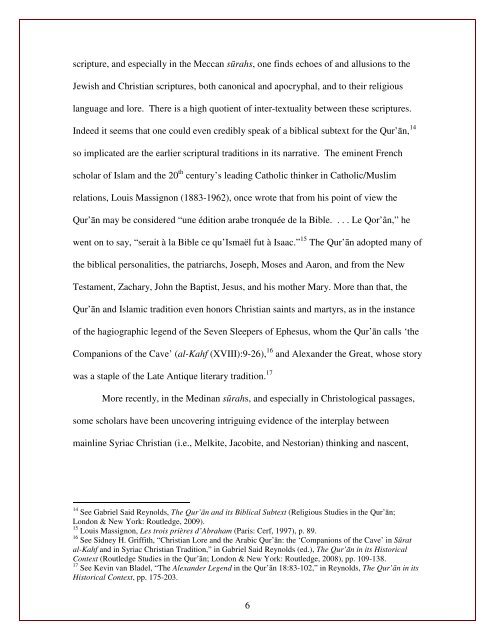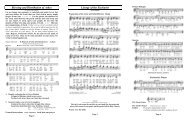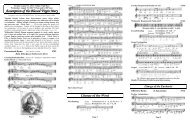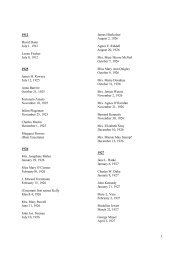The Qur'Än in Christian Thought - Saint Benedict Catholic Church
The Qur'Än in Christian Thought - Saint Benedict Catholic Church
The Qur'Än in Christian Thought - Saint Benedict Catholic Church
You also want an ePaper? Increase the reach of your titles
YUMPU automatically turns print PDFs into web optimized ePapers that Google loves.
scripture, and especially <strong>in</strong> the Meccan sūrahs, one f<strong>in</strong>ds echoes of and allusions to theJewish and <strong>Christian</strong> scriptures, both canonical and apocryphal, and to their religiouslanguage and lore. <strong>The</strong>re is a high quotient of <strong>in</strong>ter-textuality between these scriptures.Indeed it seems that one could even credibly speak of a biblical subtext for the Qur’ān, 14so implicated are the earlier scriptural traditions <strong>in</strong> its narrative. <strong>The</strong> em<strong>in</strong>ent Frenchscholar of Islam and the 20 th century’s lead<strong>in</strong>g <strong>Catholic</strong> th<strong>in</strong>ker <strong>in</strong> <strong>Catholic</strong>/Muslimrelations, Louis Massignon (1883-1962), once wrote that from his po<strong>in</strong>t of view theQur’ān may be considered “une édition arabe tronquée de la Bible. . . . Le Qor’ân,” hewent on to say, “serait à la Bible ce qu’Ismaël fut à Isaac.” 15 <strong>The</strong> Qur’ān adopted many ofthe biblical personalities, the patriarchs, Joseph, Moses and Aaron, and from the NewTestament, Zachary, John the Baptist, Jesus, and his mother Mary. More than that, theQur’ān and Islamic tradition even honors <strong>Christian</strong> sa<strong>in</strong>ts and martyrs, as <strong>in</strong> the <strong>in</strong>stanceof the hagiographic legend of the Seven Sleepers of Ephesus, whom the Qur’ān calls ‘theCompanions of the Cave’ (al-Kahf (XVIII):9-26), 16 and Alexander the Great, whose storywas a staple of the Late Antique literary tradition. 17More recently, <strong>in</strong> the Med<strong>in</strong>an sūrahs, and especially <strong>in</strong> Christological passages,some scholars have been uncover<strong>in</strong>g <strong>in</strong>trigu<strong>in</strong>g evidence of the <strong>in</strong>terplay betweenma<strong>in</strong>l<strong>in</strong>e Syriac <strong>Christian</strong> (i.e., Melkite, Jacobite, and Nestorian) th<strong>in</strong>k<strong>in</strong>g and nascent,14 See Gabriel Said Reynolds, <strong>The</strong> Qur’ān and its Biblical Subtext (Religious Studies <strong>in</strong> the Qur’ān;London & New York: Routledge, 2009).15 Louis Massignon, Les trois prières d’Abraham (Paris: Cerf, 1997), p. 89.16 See Sidney H. Griffith, “<strong>Christian</strong> Lore and the Arabic Qur’ān: the ‘Companions of the Cave’ <strong>in</strong> Sūratal-Kahf and <strong>in</strong> Syriac <strong>Christian</strong> Tradition,” <strong>in</strong> Gabriel Said Reynolds (ed.), <strong>The</strong> Qur’ān <strong>in</strong> its HistoricalContext (Routledge Studies <strong>in</strong> the Qur’ān; London & New York: Routledge, 2008), pp. 109-138.17 See Kev<strong>in</strong> van Bladel, “<strong>The</strong> Alexander Legend <strong>in</strong> the Qur’ān 18:83-102,” <strong>in</strong> Reynolds, <strong>The</strong> Qur’ān <strong>in</strong> itsHistorical Context, pp. 175-203.6






